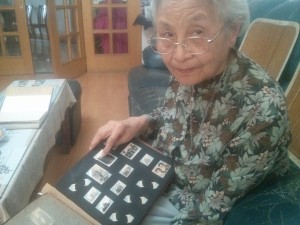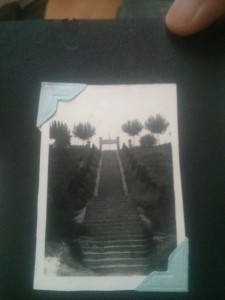Shanghai Street View: Wartime Fudan

With the 70th anniversary of the end of World War 2 in Asia fast approaching, I’ve been looking for interesting but overlooked war stories involving my adopted home of Shanghai, which was one of China’s first cities to get dragged into the conflict. Most such stories involve a mix of perseverance, resilience and defiance, as both Chinese and foreigners in Shanghai tried to maintain their daily routines as much as possible, while also resisting the enemy and awaiting the return of peace.
That’s when I realized that one of the most fascinating stories, which includes a healthy dose of all these elements, was right under my nose at Fudan University where I’ve been teaching in the Journalism School for the last 4 years. I’d heard in the past that Fudan fled Shanghai during the war and set up temporary shop in Jiangxi province or the interior city of Chongqing, but never pursued the real story to find out what actually happened and why.
What followed was my own brief journey, which began with the help Zhou Guifa , one of the journalism school’s top officials, who was formerly head of the university’s archive. He led me to former colleague Yang Jiarun , who was intimately familiar with the school’s history during that period. Yang then directed me to Huang Runsu, a 93-year-old Sichuan native and current Shanghai resident who is one of a dwindling number of war-era Fudan students who are still around and can tell their stories.
This kind of reporting was quite routine for me in my past life as a reporter, but I’ll admit I’ve gotten out of shape in recent years and found the running around and interviews quite exhausting. But the result also provided a fascinating glimpse of how people and institutions learn to cope in times of war, and made me realize how adaptable people can be under such extreme conditions.
I’ve read accounts of wartime life in Shanghai before, but it was quite different hearing the story from a knowledgeable historian like Yang, and also from someone like Huang who experienced this part of history first-hand.
Early Relocation
I learned that Fudan’s first move actually occurred quite early, in 1932 to be precise, when the school’s current campus in Yangpu District was damaged and occupied by the Japanese during one of the war’s earliest clashes. That forced Fudan’s 1,000 college students to relocate for 5 months to the campus of its smaller affiliated middle school in Xuhui District.

But the real action begins in 1937 when Japan invaded Shanghai. In response to the growing incursions, the education ministry began ordering several major universities in Beijing, Tianjin and Shanghai to relocate to safer areas. But things were developing too quickly for much central oversight, and the ministry told the Shanghai universities to find suitable new locations and finance their moves large by themselves.
After some hasty reconnaissance, Fudan decided that Lushan in Jiangxi province was a suitable new location. The area was already a popular vacation destination for many wealthy Shanghainese, and thus was close enough to the city and had much of the necessary infrastructure.
So in October 1937, some 900 Fudan students moved to the Lushan campus and began fall classes. But no sooner had classes begun then everyone began to worry about the advancing Japanese, since the new location wasn’t far from Nanjing, China’s capital at that time. Nanjing would come under siege a short time later, in what became the Nanjing Massacre of December 1937.
Having decided Lushan wasn’t safe, Fudan’s administrators hastily decided to leave the city and head for an uncertain fate in Sichuan, with a vague plan to ultimately join with a sister school that was setting up a campus in adjacent Guizhou province. Most of Fudan’s 900 students weren’t too thrilled about such a vague and dangerous journey, and only 400 showed up for a boat trip up the Yangtze River that began on December 1 and ultimately ended 3 weeks later with their arrival in Chongqing.
Fudan quickly discovered that the Guizhou plans were impractical, and instead turned to locals and the Chongqing government for help. Those efforts resulted in its relocation to a campus about 50 kilometers from the city on the banks of the Jialing River, where the university would remain throughout the war, managing not only to survive but even thrive.
Return to Shanghai
It had nearly 2,000 students by the time it returned to Shanghai in 1946 and moved back to its former campus, which the Japanese had converted to a school named Shanghai University during the war, Yang told me, finishing his story. He added with a smile that people from Fudan would later refer to the war-era school as “Fake Shanghai University”, and that part of the campus’ history has been mostly forgotten by now.
It was hard for me to imagine how people could make and execute so many major decisions so quickly at that time. I got the same sense of haste when I tracked down the lively 93-year-old Huang Runsu at her Xuhui apartment where she lives a quiet life with her son. I’ve never interviewed anyone quite so elderly before, and have to admit the process was quite tiring though I was also surprised by her strong recollections and also upbeat tone when she talked about the period.
Coming from a well-to-do Sichuan family, Huang was studying French at a university in Kunming when the war broke out and had to abandon her studies when the Japanese started bombing the city. She and a dozen classmates made their way back to Sichuan during that chaotic time, making slow progress by walking and relying on people for rides, as they sold their clothes to pay expenses.
She later enrolled at Fudan in Chongqing, and graduated in 1945. Among her memories were studying in the dining hall at night because the gas lighting was best there, and the cramped dormitories where 11 students shared each room on a series of bunk beds. One of her wartime photos showed the steep stone steps leading up to the campus from the banks of the Jialing River, a far more rugged look than Fudan’s leafy campus today in suburban Shanghai.
Despite the tough conditions, Huang also remembered the period with a certain fondness, recalling how her romance blossomed with the man who would become her future husband. She also recalled the richness of academic life in Chongqing, since many of the country’s top professors and students had fled to China’s wartime capital at that time. Huang later resumed a more normal life as a teacher, and moved to Shanghai where she worked at Fudan faculty for 38 years before retiring in 1988.
In this day and age where universities like Fudan have become massive, well-established institutions with tens of thousands of students, it’s hard to imagine that earlier era where things were smaller and difficult decisions were made and executed quickly out of necessity. I shudder today when thinking of the turbulence in the lives of students and professors of that era, and wonder how they coped.
Their perseverance, defiance and determination are certainly worthy of reflection and a strong dose of respect as we observe the 70th anniversary of the end of World War 2 in Asia. Their experience also serves as a reminder for all of us today to be grateful for the peaceful and prosperous environment we now call home here in modern Shanghai.
